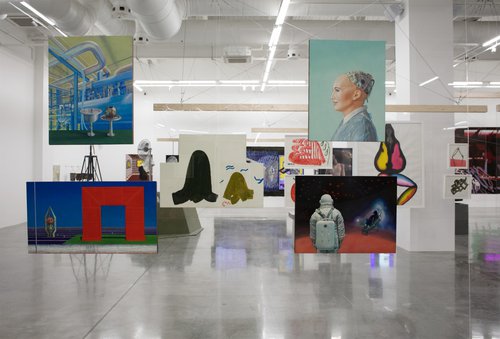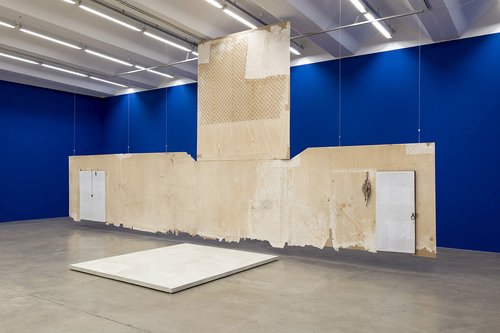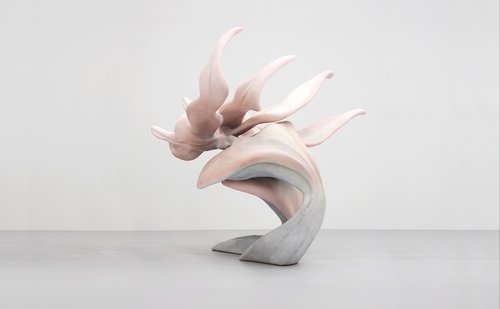ArtVilnius ’25: Where the Baltic Scene Buys In

International Contemporary Art Fair ArtVilnius. Exhibition view. Vilnius, 2025. Photo by Andrej Vasilenko. Courtesy of International Contemporary Art Fair ArtVilnius
Now a veteran in its 16th edition, the art fair in the Lithuanian capital, Vilnius, surveyed the Baltic scene with sixty galleries from sixteen countries and over three hundred artists. Catering primarily to collectors from Lithuania, Latvia, and Estonia, with a focus on new collectors, it paired a spacious curated section with the traditional gallery booths.
ArtVilnius ’25, staged in its home city of Vilnius, offered a revealing snapshot of the Baltic art scene, gathering around 60 galleries and institutions from 16 countries and works by more than 320 artists. With a curatorial focus on art collecting across Lithuania, Latvia, and Estonia, the fair showed how a mature, well-defined regional ecosystem can speak with clarity – not through spectacle, but in a steady, reflective register.
The spacious LITEXPO venue housed three main halls: two for galleries and one for the curated Project Zone, which showcased holdings from private collectors and museums. Curatorial direction was led by Sonata Baliuckaitė, Julija Dailidėnaitė, and Gabija Pulupaitė. Threading through the building – and spilling outdoors – the annual sculpture and installation platform The Path (TAKAS) reinforced a sense of continuity, featuring works by 14 artists from Lithuania, Latvia, Estonia, Ukraine, Belarus, Denmark, and the UK. Over three days the fair was buzzing: some of the booths were nearly impassable due to crowding, red dots multiplied across catalogues within hours, and children drifted between workshops and performances – a soft counterpoint to the brisk commerce.
Despite its modest scale, the fair offered a broad cross-section of art and galleries from the region. Lithuanian galleries dominated, ranging from long-established spaces to younger initiatives working with emerging artists, alongside a concentrated cluster of galleries from the Vilnius Academy of Arts (VAA). The Baltic dialogue extended further through Temnikova & Kasela (Tallinn) and Kogo (Tartu), MĀKSLA XO and Bastejs (Riga), while a handful of international galleries – Davis and Galleri NB (Denmark), TSEKH (Lithuania/Ukraine), Eristavi and Gallery Phase (Belgium), Galerie Nivet-Carzon (Paris), Wildpalms (Düsseldorf) and Foreign Territory (New York) – added a cosmopolitan flourish without overshadowing the sense of the local.
This year’s central theme – collecting art – gave the fair both intimacy and gravitas, inviting reflection on continuities within Baltic artistic traditions. To engage a broad spectrum of buyers, ArtVilnius ’25 embraced an intentionally democratic pricing strategy. Nowhere was this clearer than at the Young Collector’s Stand, which encouraged visitors to “start building their collection” with works under €700. Prices began at €110 for small acrylics by Irena Mikuličiūtė (b. 1955), dropped to €20 for objects at the Lithuanian Artists’ Association booth, and to as little as €5 for prints at Kauno Menininkų Namai.
The middle range – works on paper, paintings, and sculptures priced between €270 and €4,000 – appeared particularly popular among buyers. At the upper end of the scale, Eglė Karpavičiūtė’s (b. 1984) oil painting “Keep it to yourself. Based on ‘Comedian’ by Maurizio Cattelan”, featuring a taped banana on the wall, reached €20,000 at The Rooster Gallery, while a playful nod to it – a taped orange – appeared at the prize-winning booth of 5 Malūnai (VAA Gallery) as part of an installation by Laima Kreivytė (b. 1972). The most expensive series, comprising six works by Lithuanian abstractionist and conceptual artist L. L. Katinas (b. 1941), was assembled into a mobile installation by Meshka Tech gallery, centred around the well-known piece “Red Becomes White whilst Falling,” with an asking price of around €50,000 for series. The Room gallery from Vilnius’s Užupis district presented another classic of 20th century Lithuanian art – the paintings of abstract expressionist E. A. Cukermanas (b. 1935), with prices reaching €5,000 for one work.
If the market floor sketched a ladder of value, the collections supplied the backstory to each rung. The Project Zone sharpened the fair’s focus on collecting with a cross-section of private and institutional holdings from across the Baltics. Zuzeum (Latvia), VV Foundation (Latvia), the Kruus Collection (Estonia), COBALT Collection (LT/LV/EE), Sapieha Palace (Lithuania) and the Boris Symulevič Collection (Lithuania), among others, shaped a landscape based on stories of vision, curiosity, and persistence – an exercise in collecting as a form of cultural thinking. The collection of Epp and Martin Kruus, begun in the 1980s from a fascination with geometric abstraction, bridged local and international lineages, featuring works by Sirje Runge (b. 1950), Mari Kurismaa (b. 1956), Anselm Kiefer (b. 1945), and Katja Novitskova (b. 1984). The vivid and deeply personal collection of Olga Temnikova and Indrek Kasela – founders of the eponymous gallery also present at art fair – brought together works by Marlene Dumas (b. 1953), Pavel Pepperstein (b. 1966), Edith Karlson (b. 1983), and others. Meanwhile, the collection of Boris Symulevič, art collector and founder of Artnews.lt and Echogonewrong.com, mapped the topography of contemporary Baltic art through works by Anastasia Sosunova (b. 1993), Pakui Hardware duo, Jānis Šneiders (b. 1995), and others, carrying a subtle post-internet shimmer.
The annual curated exhibition ‘The Path’ (TAKAS) kept a sculptural and performative presence at the fair. Lithuanian artist Rokas Janušonis (b. 1997) presented ‘Sat.25’ (2025), an installation of ceramic and found objects, within ‘The Path’, while also receiving the prize for ‘Best Sculpture/Installation’ at the fair for another ceramic composition shown at the Menų Parkas Galerija (Kaunas) booth, priced at €12,000. Both pieces extended his ongoing exploration of the quiet wit and modest poetry of the ready-made. Although digital and media art appeared less prominently than in previous fair editions, ‘Desiring Machine’ (2023) by Elena Kanarskaitė, an interactive installation on the absurd precision of algorithmic desire, lent the section a subtle charge of tech reflection. Several sculptures in ‘The Path’ were also available for purchase, including Latvian sculptor Anna Egle’s (b. 1990) ‘Leaf Rays’ (2025), priced at €5,000, and ‘A Blink of the Heart’ (2025), at €9,000. Kinetic sculptures were rarer this year, though a notable exception came from the PILOT experimental space (Art Academy of Latvia), where Modris Svilāns (b. 1979) presented his ‘Pulse’ series of kinetic objects, priced at €2,500 each.
If the fair could be said to have had a prevailing mood, it was one of subtle gravity and poise. Perhaps this attentiveness itself was shaped by the very act of collecting. The visual landscape leaned toward muted tones and measured gestures, where paintings, works on paper, and objects in monochrome or softly modulated palettes embodied a melancholic composure rooted in the Baltic legacy of “silent modernism,” an art of intimacy and endurance. Even the rhythm of the fair reflected this tone, inviting thoughtful flânerie between booths. The same sensibility resonated in the choice of Matas Dūda (b. 1976) at the Academy / VAA Gallery as Best Artist: his large-format monochrome prints (€700–1,000), surrounded by sheets of metal on the floor and walls, seemed to capture the atmosphere of the present — darkened, yet quietly reaching toward clarity and resolution. The ‘Best Young Artist (under 35)’ award went to Latvian artist Sabīne Vernere (b. 1990), represented by Kogo Gallery (Tartu), for her series of geometric monochrome mixed-media abstractions.
The Rooster Gallery won ‘Best Gallery Exhibition’ accolade (Rödl & Partner) with a warmly minimal display – think light-wood storage room – where viewers lingered among works by emerging Baltic voices. Thirteen artists fit seamlessly into the space, and with newcomers in mind, prices stretched from €80 to €20,000, the top end for Eglė Karpavičiūtė’s (b. 1984) ‘banana painting’. Next door, 5 Malūnai (VAA Gallery) set the tone with Anton Lukoszevieze’s (b. 1965) audio work ‘Solo and Duet’, drawn from a 1977 radio interview with Fluxus founder George Maciunas – an elegant nod to Lithuania’s contemporary-art lineage.
Elsewhere, Donatas Repeika’s (b. 1997) ‘Attention!’ (2024), presented by Klaipėdos Galerija, captured people’s attention. The sculpture, shaped like a warning sign carved from stone, felt quietly attuned to the current moment. During ArtVilnius ’25, the Lithuanian cultural community held protests against the proposed appointment of a new national Minister of Culture: dozens of galleries, museums, and art centres signed a petition and displayed a riverbank hazard road sign with the image of a falling car replaced by the word kultūra (culture). The same symbols appeared throughout the fair – on walls, booths, even badges. Repeika’s sculptural sign was available for purchase, priced at €3,900.
Running parallel to the displays, the TALKS Studio gave the fair a reflective axis, where conversations moved with ease between theory and practice. Paco Barragán outlined a millennia-long typology of collecting “from the plunderer to the cosmopolite,” and Alain Servais reflected on collecting as “a civic act rather than an investment.” Although digital art was less visible this year, and NFTs seemed nowhere to be found, discussions still turned to the now ever dominant question of AI and its possible role and application in the art world.


























